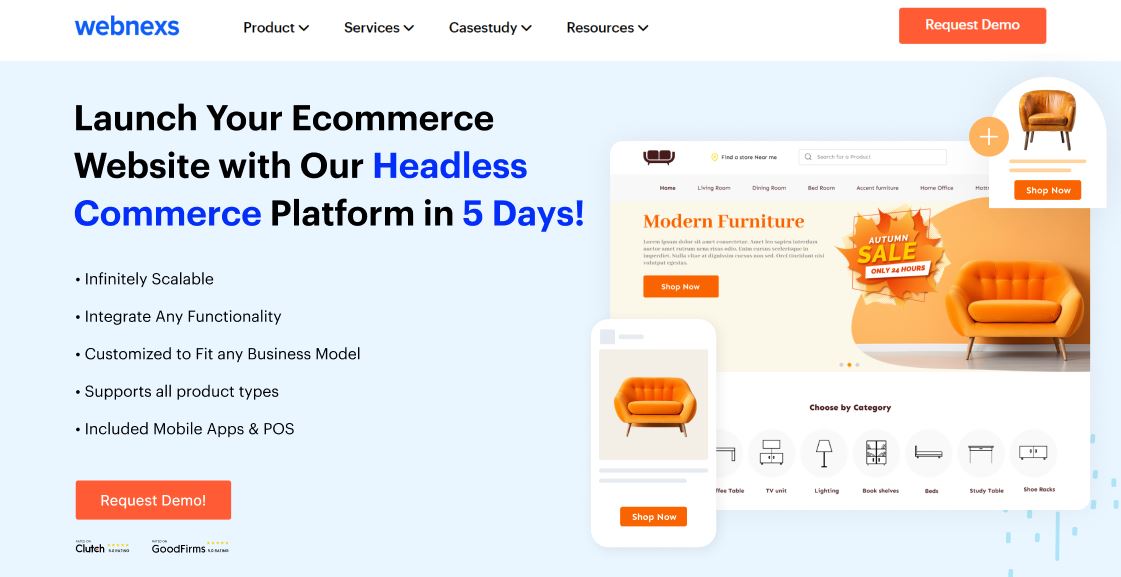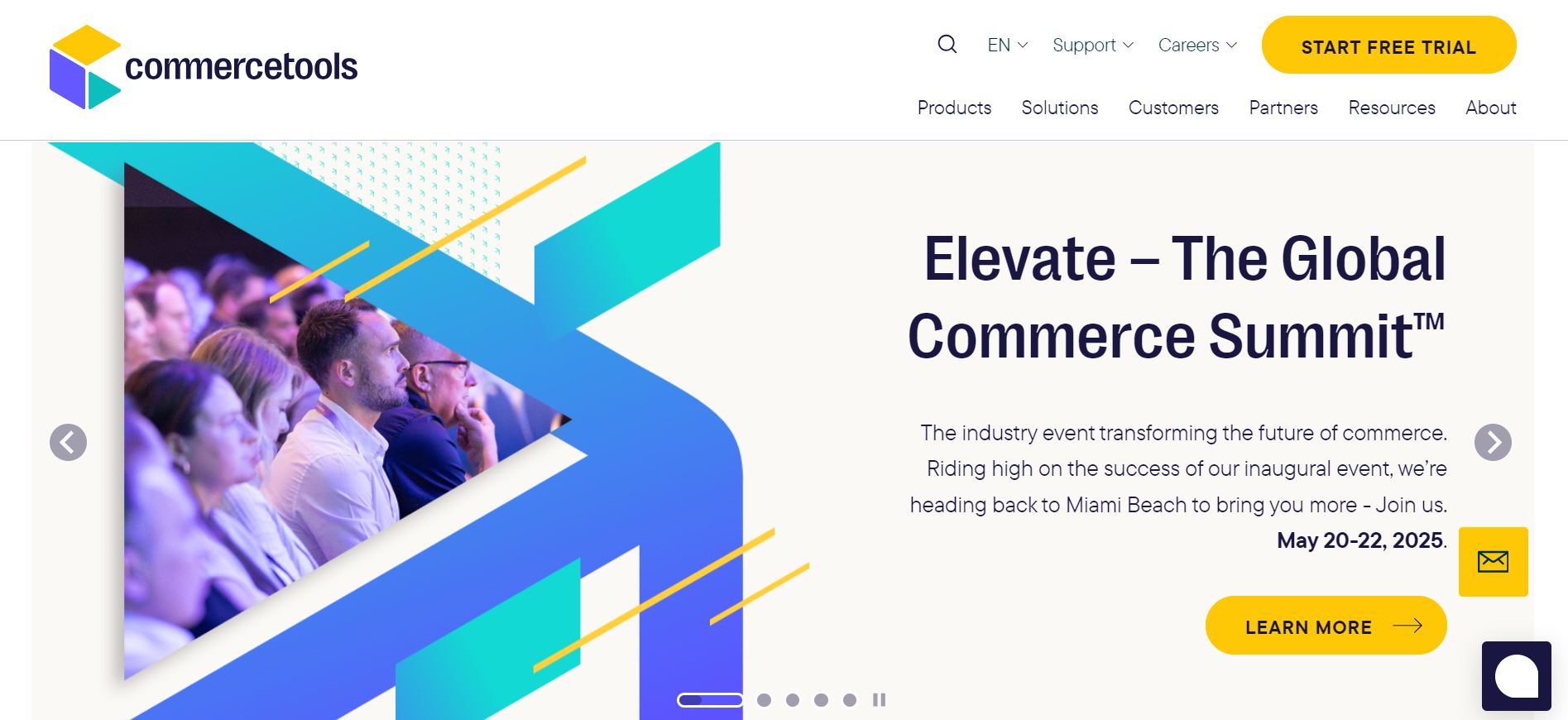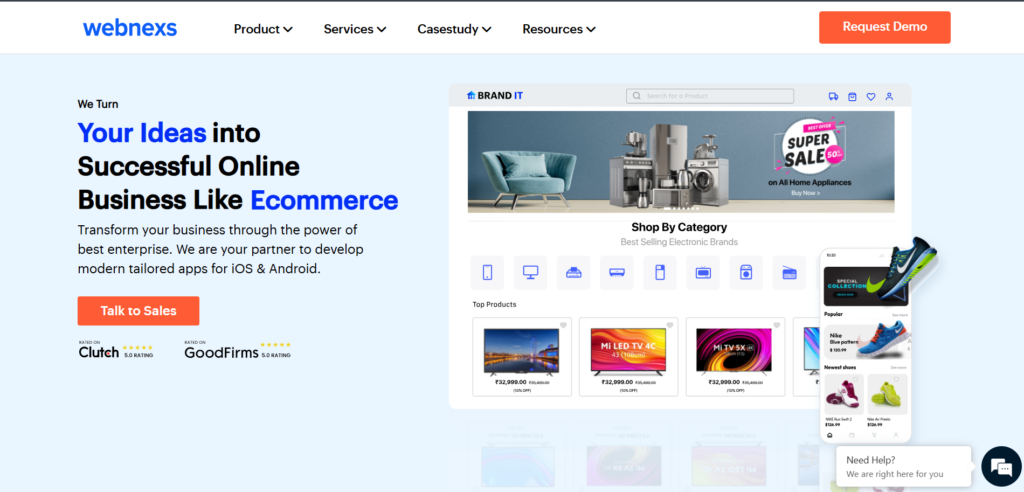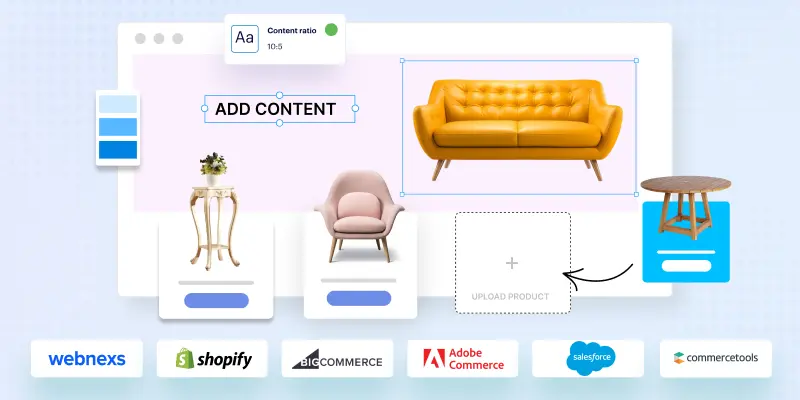Hey readers!
In the subsequent discussion, we will explore the 6 best headless ecommerce platforms to consider for starting your online business.
In recent years, there has been a noticeable shift in consumer purchasing behavior, with more customers transitioning from traditional brick-and-mortar stores to online shopping. This trend is largely driven by the widespread availability of the Internet and the instant gratification it offers.
Recent statistics indicate a growing trend towards the adoption of headless commerce, with up to 57% of headless commerce companies projected to embrace this approach by 2024. Among those who have made the switch to headless CMS, 83% have reported notable improvements in time, budget, and revenue.
Looking ahead, it is estimated that ecommerce will constitute 24.5% of global retail shopping by 2025, encompassing both B2B and B2C transactions.
Headless architecture offers businesses an efficient means to meet evolving customer expectations and deliver seamless omnichannel experiences.
By embracing a headless approach to ecommerce architecture, companies can effectively cater to the demands of B2B customers while maintaining flexibility across various channels.
Build your own headless ecommerce platforms today!
Key Takeaways On Best Headless Ecommerce Platforms
- To succeed in ecommerce, focus on platforms prioritizing flexibility, scalability, and innovation, enabling businesses to deliver personalized customer experiences with the best headless ecommerce platforms.
- Explore the 6 best headless ecommerce platforms: Webnexs, Shopify Plus, BigCommerce, Magento/Adobe Commerce, Salesforce Commerce Cloud, and Commercetools, each offering unique features to support diverse business needs.
- Key features of the top best headless ecommerce platforms include API-driven architecture, omnichannel support, seamless integrations, scalability, and faster time-to-market capabilities.
- Benefits of adopting a best headless ecommerce platforms include improved performance, enhanced personalization, better user experience, and the ability to adapt quickly to market trends.
- Overcome challenges like best headless ecommerce platforms selection, integration complexities, and maintaining buyer-seller satisfaction by focusing on strategic planning and leveraging the advanced tools offered.
Best Headless Ecommerce Platform Explained:
Best Headless ecommerce platforms make online stores more flexible by separating the front end (what customers see) from the back end (how the store runs).
This setup lets you change your store’s design like updating the layout without affecting things like order processing or inventory management. The two parts communicate through APIs, making it easy for developers to create custom designs and add new features.
Here’s how it works:
- The front end focuses on creating a smooth shopping experience for customers.
- The back end handles tasks like managing products, orders, and payments.
This separation gives businesses the flexibility to quickly adapt to changes, add new sales channels, and create unique designs that match their brand. In fact, 92% of businesses say headless eCommerce helps them deliver better shopping experiences.
With headless eCommerce, you get more control, faster updates, and a store that’s easy to manage all while keeping your customers happy.
6 Best Headless Ecommerce Platforms To Consider For Starting Your Online Business
1. Webnexs – Best Headless Commerce Platform

Webnexs stands out as a popular ecommerce platform known for its best headless commerce stores capabilities. Separating the commerce engine from the customer-facing interface enables simultaneous operation of multiple stores across various channels from a centralized hub.
It’s crafted to assist businesses of all sizes in creating distinct online stores tailored to their specific requirements. With its customizable themes and seamless API integrations, Webnexs simplifies the process of adapting and thriving in today’s competitive ecommerce market.
With Webnexs, you gain access to enterprise-level functionality and impressive app-based systems suitable for both B2B and B2C sectors. The platform is designed to support the growth ambitions of businesses, offering scalability and top-notch performance to accommodate expansion at your desired pace.
With Webnexs, businesses can enjoy the following best headless commerce platform features:
- 100% Customize your platform to fit your business and branding.
- Access a wide range of 100+ features to improve your store’s functionality.
- Choose from 20+ free themes to create an appealing storefront.
- Integrate easily with over 100 APIs for added functionalities.
- Host your store with any provider to ensure reliability and strong performance.
- 100% Optimize your store for search engines to attract more traffic.
- Advertise on platforms like Google, AdRoll, and Bing to effectively reach your target audience.
- Get dedicated email support for any issues you encounter.
2. Shopify – Best Headless Commerce Sites

Shopify is known for its easy setup and tons of apps, making it popular for both beginners and big headless commerce companies.
Shopify used to be just a regular ecommerce platform, but now it has Shopify Plus, a more advanced version. This is for bigger businesses that need extra features and flexibility. It’s like Shopify’s cooler, more powerful sibling.
With Shopify Plus, you can count on your store running smoothly, even during busy times like sales. Plus, the dashboard is easy to use, even if you’re new to eCommerce.
Their customer service is pretty good too. You can get help in different ways, and Plus users even get their own support person. Plus, there’s a helpful community forum and a detailed help center for any questions you might have.
With Shopify Plus, businesses can enjoy the following best headless ecommerce platform features:
- It works with popular tools like Mailchimp and Google Sheets.
- Enjoy live chat and phone support, along with access to a dedicated account manager.
- You can customize everything from themes to payments.
- They have resources and training to help you boost sales.
3. BigCommerce – Top Headless Commerce Platforms

BigCommerce is a leading name in headless commerce companies and provides a headless commerce options. This means you can separate the back end of your online store from the front end, allowing you to manage multiple stores across different channels all from one central spot.
They provide different front end framework options, like Next.js, Gatsby.js, and Nuxt.js. Each one has its own benefits, such as turning your store into a progressive web app or offering an intuitive framework for building the front end.
BigCommerce’s open API headless architecture, along with its wide range of apps, makes it easy to customize and adapt your store to changing customer needs.
It’s a dream platform for developers, offering lots of freedom and flexibility. Plus, the pre-integrated apps make it simple to connect your store to helpful tools.
BigCommerce promises 99.99% average uptime, meaning your store stays online even during busy times or when you have lots of orders.
With BigCommerce, businesses can enjoy the following top headless commerce platform features:
- Themes with customizable HTML, CSS, and JavaScript are fully adaptable.
- Unlimited checkout customization.
- Mobile optimization for a great experience on different devices.
- Integration with WordPress.
- An easy drag-and-drop page builder.
4. Magento/Adobe Commerce – Best Headless Commerce Stores

Adobe Commerce, formerly known as Magento, adopts a headless approach to ecommerce, offering extensive customization and omnichannel capabilities. This platform empowers developers to create tailored applications to meet the unique needs of their customers, allowing for a personalized ecommerce experience.
Catering directly to customer needs is crucial, especially with the increasing demand for shopping across multiple channels. Adobe Commerce’s omnichannel approach addresses this need effectively.
One standout feature of Adobe Commerce is its robust inventory management system, providing real-time tracking of stock across all locations. Additionally, the platform offers advanced data visualization tools for comprehensive analytics, enabling businesses to make informed decisions and enhance sales strategies.
Adobe Commerce also supports custom integrations through web API frameworks, allowing for seamless integration with CMS, marketing, accounting, and inventory management systems. However, it’s important to note that leveraging this high level of customization may require development expertise or outsourcing.
With Adobe Commerce, businesses can enjoy the following best headless commerce platform features:
- SEO capabilities to improve online visibility
- Sophisticated inventory management system
- Comprehensive help center with self-service options
- Support for various payment gateways to enhance the customer experience.
5. Salesforce – Best Headless Commerce Option

Salesforce Commerce Cloud, developed by the CRM giant Salesforce, offers the best headless commerce platform with customizable APIs for both front-end and back-end experiences.
As a product of Salesforce, Commerce Cloud effortlessly integrates with the company’s content management system, allowing for personalized customer interactions by leveraging existing Salesforce data.
While Commerce Cloud provides numerous tools and integrations, it may not be as user-friendly for beginners compared to platforms like Shopify. Its multiple APIs might require more time to learn, making it better suited for businesses with a dedicated development team.
With Salesforce Commerce Cloud, businesses can enjoy the following best headless commerce platforms features:
- Order management platform
- Extensive integration options
- Support for both B2B and B2C ecommerce
- “Endless Aisle” feature for integrating digital and physical touchpoints
- Easy mobile optimization
6. Commercetools – Best Headless Ecommerce Company

Commercetools is an ecommerce platform that puts APIs first, allowing for highly customizable customer experiences that can boost average order value and conversion rates. It caters to both B2C and B2B sellers, offering features for both types of businesses.
One of Commercetools strengths is its ability to deploy ecommerce experiences across various touchpoints, including mobile apps, websites, and voice assistants, thanks to its API-driven architecture. With comprehensive APIs covering everything, there’s no need for SQL or other customizations.
While Commercetools offers fewer integrations compared to some other platforms, it still provides various options for payment management, content management, and CMS systems.
Although not ideal for complete beginners due to its API-driven nature, Commercetools boasts a clean and straightforward user interface. However, customer service options are limited, so relying on community support may be necessary for technical queries.
With Commercetools, businesses can enjoy the following best headless commerce platform features:
- Order management tools
- Cloud-based infrastructure
- A/B testing capabilities
- Robust backend that remains stable even during traffic spikes.
Headless Ecommerce adopts a modular approach, separating the front-end and back-end components. This separation provides enhanced flexibility and scalability, allowing businesses to leverage diverse tools and technologies for each aspect independently.
Conversely, Traditional Ecommerce relies on an all-in-one solution where a singular platform oversees every aspect, from the user interface to database management and payment processing. Here, the front-end and back-end are closely intertwined, necessitating adjustments to both when altering the front-end.
Create Your Best Headless commerce Platforms Now!
4 Key Components You Should Know Before Choosing Headless Ecommerce Platforms:

If you’re considering the best headless ecommerce platform for your store, integrating the best headless CMS for ecommerce could be highly advantageous, and there are a few things you should keep in mind:
1. You’ll Need a Frontend
Because headless ecommerce platforms separate the front and back end, you’ll need to create a frontend architecture to display your products and interact with customers, often utilizing a headless CMS for content management and advanced frontend development techniques. This can be a custom-built frontend or a third-party frontend framework.
Interesting facts!
77% of organizations with headless architecture report that it enables faster changes to storefronts.
2. APIs are Key
To connect your frontend and backend in a headless ecommerce software setup, an API-first approach are necessary. APIs establish communication rules for different software components. With a customizable online store, you’ll be relying heavily on APIs to ensure that your frontend and backend can talk to each other seamlessly.
Interesting facts!
Over 90% of developers use APIs in some capacity, according to Nordicapis. This includes 69% utilizing third-party APIs and 20% relying on internal or private APIs, highlighting their central role in modern development.
3. Multi-Channel Support
Headless ecommerce platforms empower businesses to deliver their ecommerce experience smoothly across various channels and devices, such as web, mobile, social media, and voice assistants, among others. This can help businesses find new customers and give customers more choices.
Interesting facts!
63% of retail companies plan to migrate to headless commerce platforms by 2024 to meet evolving consumer demands.
4. Integration with Other Systems
Decoupled ecommerce systems can be easily integrated with other systems and tools, such as marketing automation platforms, headless CMS for ecommerce, CRM software and analytics tools. When businesses combine their systems, they can improve their marketing and sales plans and learn more about how their customers behave. This helps them improve how they work and do even better.
Interesting facts!
By 2023, it’s expected that 57% of organizations globally will be using headless commerce platforms, underscoring the trend toward integrated, flexible solutions.
Learn More: Headless Commerce Architecture: Discover The Future of Online Retail
5 Key Features To Consider From These Best Headless Ecommerce Platforms

Headless commerce is changing the way businesses operate, offering unmatched flexibility to meet modern customer needs. But what makes the top platforms so unique?
we’ll explore the five standout features of the best headless ecommerce platforms and understand how they empower businesses to success in a fast-evolving market.
Here are the five key features to consider from these top headless commerce platforms:
- Customer Analytics and Insights
Understanding customer behavior is essential to deliver personalized experiences. Headless commerce platforms integrate with analytics tools to track customer behavior and provide valuable insights, enabling businesses to deliver relevant content to their audience.
Fact – A retail brand improved its click-through rates by 35% using advanced analytics integrations.
- Headless Storefronts
Headless storefronts allow ecommerce brands to present personalized content effortlessly across various channels. The decoupled nature of headless commerce empowers developers to manage and deliver content flexibly without extensive coding requirements.
Fact – A global fashion retailer reduced time-to-market by 40% using a headless storefront.
- Application Programming Interface (API)
Headless commerce platforms prioritize API-first approaches for content delivery, offering agility and flexibility. Content is stored in a database system and delivered through APIs to different platforms such as websites, social media, and mobile apps, ensuring easy content delivery across channels.
Fact – Over 90% of developers use APIs for efficient integration and development, according to Nordic APIs.
- Content Delivery Network (CDN)
Headless commerce systems leverage CDNs to distribute content efficiently, ensuring swift delivery to users. This integration enhances website management, particularly for high-traffic sites with a global audience, facilitating seamless content accessibility across channels.
Fact – A study found that websites using CDNs load 70% faster, improving conversion rates.
- Faster Page Loading
Headless commerce solutions prioritize faster page loading, providing users with a smooth and efficient shopping experience that encourages engagement and retention.
Fact – Every second of delay in page loading reduces conversions by 7%, according to Kissmetrics.
9 Benefits ecommerce businesses get with these Best Headless Commerce Platforms

Discover the 9 benefits of embracing top headless ecommerce platforms
- Improved Speed and Performance
Faster websites enhance user experience and reduce bounce rates. Top headless ecommerce platforms deliver content via APIs, ensuring quicker delivery and improved page speed. - Simplified Development and Flexibility
Headless architecture simplifies the development process, allowing teams to preserve their preferred technologies while enjoying flexibility in backend and frontend solutions. - Scalability and Future-Proofing
Headless ecommerce technology is adaptable to emerging touchpoints and technologies, ensuring scalability and performance as businesses evolve. - Effortless Testing of New Technologies
Headless architecture enables development teams to experiment with new solutions without disrupting backend processes, fostering innovation and efficiency. - Full Control of Platform Architecture
With a top headless commerce platforms, brands have full ownership and control of their platform architecture, enabling customization and optimization as needed. - Enhanced Marketing Efficiency
Marketers can execute various promotional tactics seamlessly with headless ecommerce platforms, driving customer engagement and sales. - Rapid Global Rollouts
Top headless commerce platforms facilitate multinational rollouts with multicurrency and multilanguage support, ensuring optimized rankings and global data orchestration. - Improved Customer Acquisition Metrics
Headless ecommerce solutions lead to lower customer acquisition costs and improved user experiences, resulting in higher conversion rates and repeat purchases. - Omnichannel Experience
To meet the demands of modern consumers, the best headless ecommerce platforms enable smooth experiences across multiple touchpoints, enhancing customer satisfaction and loyalty.
Do you know?
61% of customers expect personalized experiences, A upstart commerce report by Think with Google indicates that a majority of customers want brands to deliver personalized shopping experiences.
How Much Does Headless Ecommerce Cost to build the best headless ecommerce platforms?

We’ve explored what headless ecommerce is, how it works, and the top headless commerce examples, along with their benefits. Now, let’s explore the most important question: How much does headless cost?
Well, it’s not exactly cheap, but it’s worth it. The initial setup cost depends on how much you want to customize things. A custom-built solution will cost more. But what you’re really paying for is the ability to have full control and flexibility over your e-commerce platform.
Then, there’s the ongoing maintenance. Like any system, headless ecommerce needs regular updates and integrations with other tools like your CMS, CRM, or PIM. These tools also come with their costs, but they help make everything run smoothly and keep your platform ready for the future.
In short, while the cost might seem high at first, it’s a smart investment for long-term growth. With a headless ecommerce structure, you get the flexibility and scalability to grow and adapt as your business evolves.
Tip – Balance initial expenses with long-term benefits by choosing a platform aligned with your business needs.
5 Key Factors Influencing Cost in Headless Ecommerce Solutions

When you’re considering a headless ecommerce solution, it’s important to understand what can affect the overall costs. Here are five key factors to keep in mind:
- Platform Complexity
More advanced headless platforms with extra features can be pricier. Choose one that fits your needs without unnecessary extras. - Integration Needs
Connecting to third-party services (like payment processors or inventory tools) adds costs. Focus on essential integrations. - Customization Requirements
Customizing your platform for branding and user experience can increase costs. Balance essential features with custom needs to control expenses. - Hosting and Maintenance
Separate hosting and maintenance costs can vary. Managed services may offer support but at a higher price. - Development and Implementation
Design, coding, and testing can drive up costs. If you lack internal resources, hiring external developers can further increase the budget. Plan ahead to manage these expenses.
How to choose the best Headless Ecommerce Platform?

Choosing the best Headless commerce Platform is crucial for businesses seeking flexibility and customization. Here are key factors to consider:
- Integration Capabilities
Look for platforms that offer seamless integration between front-end and back-end systems, ensuring a smooth user experience and efficient order processing. - Content Modeling
Prioritize platforms that support robust content modeling capabilities, enabling consistent and engaging user experiences across all channels. - Payment Gateway Integration
Opt for platforms that integrate with various payment gateways to ensure secure and convenient payment transactions for customers. - Workflow Enhancements
Choose platforms with workflow enhancements architecture to streamline and automate eCommerce workflows, improving efficiency and accuracy. - Customer Support
Select providers that offer responsive customer support to resolve technical issues promptly and ensure smooth eCommerce operations. - Security
Ensure that platforms have robust security measures in place to protect customer data and financial transactions from cyber threats. - API-First Approach
Look for platforms that adopt an API-first approach, allowing for flexibility, scalability, and seamless integration with other systems and services. - Cost
Evaluate pricing structures carefully to find a solution that fits your budget while delivering the desired features and functionalities.
Choose The Best Headless commerce Platforms Now!
Why Choose Webnexs to Build Your Best Headless Ecommerce Platform?

When it comes to creating a strong and scalable headless ecommerce platform, Webnexs stands out as a trusted partner. Here’s a case study that highlights why businesses choose Webnexs for their ecommerce transformation.
Case Study: Halwakadai’s Success with Webnexs
Halwakadai.com, a traditional halwa store in India, faced significant challenges transitioning to the online marketplace. Despite their strong local reputation, they struggled with high cart abandonment rates, limited website features, and the absence of a mobile application.
The Webnexs Solution
Webnexs stepped in to address these issues with a tailored approach:
- Enhanced Website Features
Added functionality like coupon codes, shipment tracking, and mobile-friendly designs to improve user experience.
- Mobile Application Development
Built a user-friendly mobile app, expanding Halwakadai’s reach to mobile customers.
- Optimized UI/UX
Balanced traditional aesthetics with modern design elements for an engaging online shopping experience.
- Strategic Marketing
Launched targeted email and social media campaigns to drive traffic and improve conversions.
The Results
- Tripled Online Sales
The improved website and mobile app significantly boosted Halwakadai’s online revenue.
- Reduced Cart Abandonment
Streamlined checkout processes and enhanced features reduced cart abandonment rates.
- Expanded Customer Base
Daily customer numbers increased, along with product variety and repeat purchases.
- Improved Brand Recognition
The seamless integration of online and offline channels strengthened the Halwakadai brand.
By partnering with Webnexs, Halwakadai transformed its online presence, achieving rapid growth and a more satisfied customer base.
Conclusion
To stay competitive online, companies must produce top-notch content and choose the top headless commerce platforms to enhance their customers digital experience.
After reviewing 6 of the best headless ecommerce platforms, we’ve identified solutions that offer immense value, robust ecommerce functionality, and optimization opportunities. These platforms can help you create the ultimate ecommerce digital experience.
Whether your business operates in B2C or B2B ecommerce, a headless ecommerce solution can meet your specific requirements. Webnexs Best Headless Ecommerce Platform stands out as one of the best options, offering customizable front-end and back-end solutions to adapt to evolving customer needs while staying relevant through a headless approach.






4 Responses
Your writing always leaves me feeling uplifted and empowered. This 6 best headless ecommerce platform works great. Thank you for being such a positive influence.
Thank you for this comprehensive and engaging article. Your clear and concise writing style makes it easy to follow along, even with more complex topics. I learned a lot from this post about top headless commerce platforms and will definitely be referring back to it in the future. Keep up the great work!
It was a pleasure reading this interesting and thorough article. Even while discussing more advanced subjects, your writing style remains plain and simple. This is a great post that I will be using again and again because of how much I learnt about best headless ecommerce platforms. You are doing an excellent job.
I am not sure where youre getting your info but good topic I needs to spend some time learning much more about the headless ecommerce platforms or understanding more Thanks for magnificent info I was looking for this information for my mission